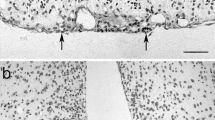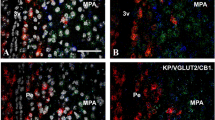Abstract
The hypophysial pars tuberalis (PT) acts as an important interface between neuroendocrine brain centers (hypothalamus, pineal organ) and the pars distalis (PD) of the hypophysis. Recently, we have identified an endocannabinoid system in the PT of hamsters and provided evidence that 2-arachidonoylglycerol is a messenger molecule that appears to play an essential role in seasonal reproduction and prolactin release by acting on the cannabinoid receptors in the PD. We now demonstrate the enzymes involved in endocannabinoid synthesis and degradation, namely sn-1-selective diacylglycerol lipase α, N-acylphosphatidylethanolamine-specific phospholipase D, and monoacylglycerol lipase, in the PT of man by means of immunohistochemistry. High-performance liquid chromatography coupled with tandem mass spectrometry revealed 2-arachidonoylglycerol and other endocannabinoids in the human PT. Furthermore, we detected the expression of the cannabinoid receptor 1 (CB1), a primary receptor for endocannabinoids, in the PD. Double-immunofluorescence staining for CB1 and various hypophysial hormones or S-100, a marker for folliculostellate (FS) cells, revealed that CB1 immunoreactivity was mainly localized to corticotrophs and FS-cells. A limited number of lactotrophs and somatotrophs also showed CB1 immunoreactivity, which was however absent from gonadotrophs and thyrotrophs. Our data thus indicate that the human PT comprises an endocannabinoid system, and that corticotrophs and FS-cells are the main target cells for endocannabinoids. The functional significance of this newly discovered pathway remains to be elucidated in man; it might be related to the control of stress responses and/or reflect a remnant seasonal control of hypophysial hormonal secretion.




Similar content being viewed by others
References
Arendt J (1995) Melatonin and the mammalian pineal gland. Chapman & Hall, London
Bisogno T, Howell F, Williams G, Minassi A, Cascio MG, Ligresti A, Matias I, Schiano-Moriello A, Paul P, Williams EJ, Gangadharan U, Hobbs C, Di Marzo V, Doherty P (2003) Cloning of the first sn1-DAG lipases points to the spatial and temporal regulation of endocannabinoid signaling in the brain. J Cell Biol 163:463–468
Böckers TM, Bockmann J, Fauteck JD, Wittkowski W, Sabel BA, Kreutz MR (1996) Evidence for gene transcription of adenohypophyseal hormones in the ovine pars tuberalis. Neuroendocrinology 63:16–27
Bockmann J, Böckers TM, Winter C, Wittkowski W, Winterhoff H, Deufel T, Kreutz MR (1997) Thyrotropin expression in hypophyseal pars tuberalis-specific cells is 3, 5, 3’-triiodothyronine, thyrotropin-releasing hormone, and pit-1 independent. Endocrinology 138:1019–1028
Cravatt BF, Giang DK, Mayfield SP, Boger DL, Lemer RA, Gilula NB (1996) Molecular characterization of an enzyme that degrades neuromodulatory fatty-acid amides. Nature 384:83–87
Devnath S, Inoue K (2008) An insight to pituitary folliculo-stellate cells. J Neuroendocrinol 20:687–691
Di Marzo V, Bifulco M, De Petrocellis L (2004) The endocannabinoid system and its therapeutic exploitation. Nat Rev Drug Discov 3:771–784
Gall C von, Garabette ML, Kell CA, Frenzel S, Dehghnai F, Schumm-Draeger PM, Weaver DR, Korf HW, Hastings MH, Stehle JH (2002a) Rhythmic gene expression in pituitary depends on heterologous sensitization by the neurohormone melatonin. Nat Neurosci 5:234–238
Gall C von, Stehle JH, Weaver DR (2002b) Mammalian melatonin receptors: molecular biology and signal transduction. Cell Tissue Res 309:151–162
Gall C von, Weaver DR, Moek J, Jilg A, Stehle JH, Korf HW (2005) Melatonin plays a crucial role in the regulation of rhythmic clock gene expression in the mouse pars tuberalis. Ann NY Acad Sci 1040:508–511
Gonzalez S, Manzanares J, Berrendero F, Wenger T, Corchero J, Bisogno T, Romero J, Fuentes JA, Di Marzo V, Ramos JA, Fernandez-Ruiz J (1999) Identification of endocannabinoids and cannabinoid CB(1) receptor mRNA in the pituitary gland. Neuroendocrinology 70:137–145
Gross DS (1984) The mammalian hypophysial pars tuberalis: a comparative immunocytochemical study. Gen Comp Endocrinol 56:283–298
Hanon EA, Lincoln GA, Fustin JM, Dardente H, Masson-Pevet M, Morgan PJ, Hazlerigg DG (2008) Ancestral TSH mechanism signals summer in a photoperiodic mammal. Curr Biol 18:1147–1152
Hazlerigg DG, Morgan PJ, Messager S (2001) Decoding photoperiodic time and melatonin in mammals: what can we learn from the pars tuberalis? J Biol Rhythms 16:326–335
Joseph-Vanderpool JR, Rosenthal NE, Chrousos GP, Wehr TA, Skwerer R, Kasper S, Gold PW (1991) Abnormal pituitary-adrenal responses to corticotropin-releasing hormone in patients with seasonal affective disorder: clinical and pathophysiological implications. J Clin Endocrinol Metab 72:1382–1387
Karlsson M, Contreras JA, Hellman U, Tornqvist H, Holm C (1997) cDNA cloning, tissue distribution, and identification of the catalytic triad of monoglyceride lipase. J Biol Chem 272:27218–27223
Kunos G (2007) Understanding metabolic homeostasis and imbalance: what is the role of the endocannabinoid system? Am J Med 120:S18–S24
Lincoln GA, Andersson H, Loudon A (2003) Clock genes in calendar cells as the basis of annual timekeeping in mammals—a unifying hypothesis. J Endocrinol 179:1–13
Magnusson A, Boivin D (2003) Seasonal affective disorder: an overview. Chronobiol Int 20:189–207
Matsuda LA, Lolait SJ, Brownstein MJ, Young AC, Bonner TI (1990) Structure of a cannabinoid receptor and functional expression of the cloned cDNA. Nature 346:561–564
Morgan PJ (2000) The pars tuberalis: the missing link in the photoperiodic regulation of prolactin secretion? J Neuroendocrinol 12:287–295
Munro S, Thomas KL, Abu-Shaar M (1993) Molecular characterization of a peripheral receptor for cannabinoids. Nature 365:61–65
Murphy LL, Munoz RM, Adrian BA, Villanua MA (1998) Function of cannabinoid receptors in the neuroendocrine regulation of hormone secretion. Neurobiol Dis 5:432–446
Nakao N, Ono H, Yamamura T, Anraku T, Takagi T, Higashi K, Yasuo S, Katou Y, Kageyama S, Uno Y, Kasukawa T, Iigo M, Sharp PJ, Iwasawa A, Suzuki Y, Sugano S, Niimi T, Mizutani M, Namikawa T, Ebihara S, Ueda HR, Yoshimura T (2008) Thyrotrophin in the pars tuberalis triggers photoperiodic response. Nature 452:317–322
Okamoto Y, Morishita J, Tsuboi K, Tonai T, Ueda N (2004) Molecular characterization of a phospholipase D generating anandamide and its congeners. J Biol Chem 279:5298–5305
Olah M, Milloh H, Wenger T (2008) The role of endocannabinoids in the regulation of luteinizing hormone and prolactin release. Differences between the effects of AEA and 2AG. Mol Cell Endocrinol 286:S36–S40
Ono H, Hoshino Y, Yasuo S, Watanabe M, Nakane Y, Murai A, Ebihara S, Korf HW, Yoshimura T (2008) Involvement of thyrotropin in photoperiodic signal transduction in mice. Proc Natl Acad Sci USA 105:18238–18242
Pagotto U, Marsicano G, Fezza F, Theodoropoulou M, Grubler Y, Stalla J, Arzberger T, Milone A, Losa M, Di Marzo V, Lutz B, Stalla GK (2001) Normal human pituitary gland and pituitary adenomas express cannabinoid receptor type 1 and synthesize endogenous cannabinoids: first evidence for a direct role of cannabinoids on hormone modulation at the human pituitary level. J Clin Endocrinol Metab 86:2687–2696
Pagotto U, Marsicano G, Cota D, Lutz B, Pasquali R (2006) The emerging role of the endocannabinoid system in endocrine regulation and energy balance. Endocr Rev 27:73–100
Piomelli D (2003) The molecular logic of endocannabinoid signalling. Nat Rev Neurosci 4:873–884
Reiter RJ (1980) The pineal and its hormones in the control of reproduction in mammals. Endocr Rev 1:109–131
Rodriguez de Fonseca F, Wenger T, Navarro M, Murphy LL (1999) Effects of delta9-THC on VIP-induced prolactin secretion in anterior pituitary cultures: evidence for the presence of functional cannabinoid CB1 receptors in pituitary cells. Brain Res 841:114–122
Rosenthal NE, Sack DA, Skwerer RG, Jacobsen FJ, Wehr TA (1988) Phototherapy for seasonal affective disorder. J Biol Rhythms 3:101–120
Unfried C, Ansari N, Yasuo S, Korf HW, Gall C von (2009) Impact of melatonin and molecular clockwork components on the expression of thyrotropin β-chain (Tshb) and the Tsh receptor in the mouse pars tuberalis. Endocrinology 150:4653–4662
Unfried C, Burbach G, Korf HW, Gall C von (2010) Melatonin receptor 1-dependent gene expression in the mouse pars tuberalis as revealed by cDNA microarray analysis and in situ hybridization. J Pineal Res 48:148–156
Wang H, Dey SK, Maccarrone M (2006) Jekyll and Hyde: two faces of cannabinoid signaling in male and female fertility. Endocr Rev 27:427–448
Wenger T, Fernandez-Ruiz JJ, Ramos JA (1999) Immunocytochemical demonstration of CB1 cannabinoid receptors in the anterior lobe of the pituitary gland. J Neuroendocrinol 11:873–878
Wenger T, Jamali KA, Juaneda C, Bacsy E, Tramu G (2000) The endogenous cannabinoid, anandamide regulates anterior pituitary secretion in vitro. Addict Biol 5:59–64
Yasuo S, Yoshimura T, Ebihara S, Korf HW (2009) Melatonin transmits photoperiodic signals through the MT1 melatonin receptor. J Neurosci 29:2885–2889
Yasuo S, Yoshimura T, Ebihara S, Korf HW (2010a) Photoperiodic control of TSH-β expression in the mammalian pars tuberalis has different impacts on the induction and suppression of the hypothalamo-hypophysial gonadal axis. J Neuroendocrinol 22:43–50
Yasuo S, Koch M, Schmidt H, Ziebell S, Bojunga J, Geisslinger G, Korf HW (2010b) An endocannabinoid system is localized to the hypophysial pars tuberalis of Syrian hamsters and responds to photoperiodic changes. Cell Tissue Res 340:127–140
Author information
Authors and Affiliations
Corresponding author
Additional information
This study was supported by the Alfons und Gertrud Kassel-Stiftung, Frankfurt am Main, Germany, and the LOEWE Lipid Signaling Forschungszentrum Frankfurt (LiFF).
Rights and permissions
About this article
Cite this article
Yasuo, S., Unfried, C., Kettner, M. et al. Localization of an endocannabinoid system in the hypophysial pars tuberalis and pars distalis of man. Cell Tissue Res 342, 273–281 (2010). https://doi.org/10.1007/s00441-010-1066-5
Received:
Accepted:
Published:
Issue Date:
DOI: https://doi.org/10.1007/s00441-010-1066-5




